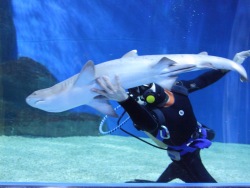New dwellers of the “World of Sharks” exhibit.

One more shark species has been added to the Aquarium’s collection of large marine predators. Two male whitetip reef sharks have been moved from the Research Building for Adaptation to the main building of the Aquarium and placed in the “World of Sharks” exhibit.
“This tank, equipped with a cave and grottoes, is a perfect dwelling for whitetip sharks,” said Mikhail Streltsov, Head of the Tropical Marine Fish Department. “The newcomers will have to compete with the stingrays for a place in the cave, but they are sure to feel at home in this tank.”
The whitetip reef shark has a slender body and a broad flattened head. White-tipped dorsal and caudal fins are its significant features due to which the species got its name. Unlike most related species that must constantly swim in order to breathe, whitetip sharks don’t have to do it. On the contrary, they can remain absolutely motionless for a long time. During the day sharks lie still on the bottom of the cave they have chosen. They could be taken for peaceful stay-at-homes but sharks’ permanent grins showing the first of 50 tooth rows leave no doubt that their owners are merciless killers.
Whitetip reef sharks are nocturnal predators with a wide range of tools for detecting potential prey. They are highly responsive to electrical, chemical and acoustic signals emitted by marine inhabitants. Having a slim flexible body, whitetip reef sharks can get into narrow crevices and cracks in the reefs to extract the prey inaccessible to other predators. Sharks can break off pieces of coral in their vigorous pursuit of prey, giving it no chance to survive.
“Our task is to keep them well fed because a satiated predator is not interested in hunting,” Mikhail Streltsov said. “If not hungry, sharks don’t usually eat anything but whitetip reef sharks are rather ill-tempered. Since the “World of Sharks” tunnel is interconnected with the “Great Reef” tank containing a vast number of bony fish, one of the basic components of sharks’ diet in the wild, we have reinforced the grid dividers between the tunnels with additional lattices.”
The whitetip reef sharks were kept in the Research Building for Adaptation from September, 2016 till October, 2018. They needed the time to become large enough to be moved to their new home, and by now one of the males has reached a length of 180 cm, the length of the second shark is 110 cm. To change the biological rhythms of the nocturnal fish, the ichthyologists have been feeding them in the daytime for 2 years. The Aquarium’s visitors can both get acquainted with the shark species and watch the predators being fed.